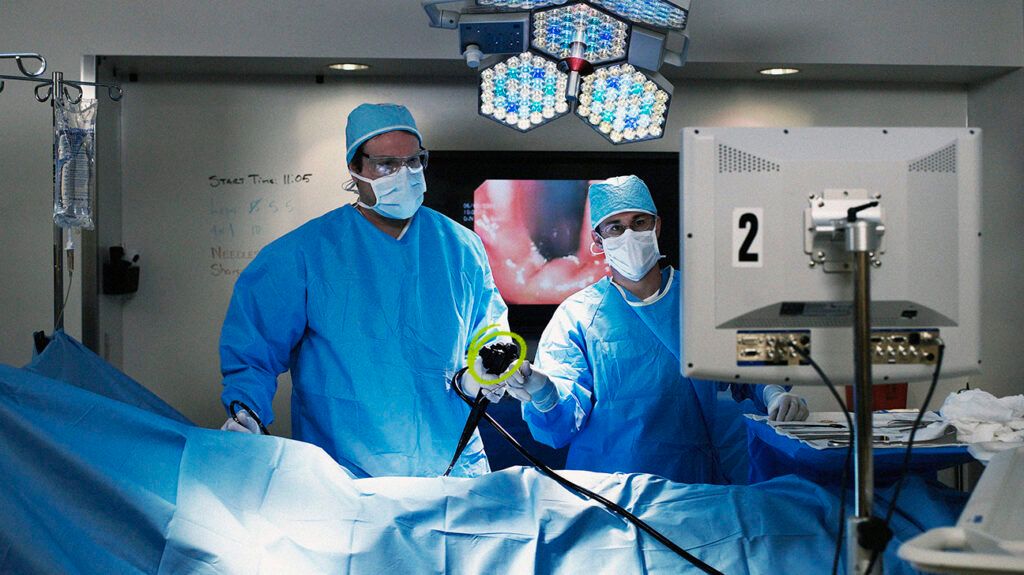Endoscopy is a broad term for a camera being inserted to look at a part of the body. Laryngoscopy is a subtype of endoscopy and can help treat issues in the larynx (or voice box).
A laryngoscopy and an endoscopy are both diagnostic tools. Doctors also use these tools during treatment for certain conditions.
This article looks at the difference between the two procedures, what to expect with each, and a comparison of a laryngoscopy with a bronchoscopy.

Further details pertaining to laryngoscopy and endoscopy are outlined below.
Part of the body
A laryngoscopy primarily
Laryngoscopy is a type of endoscopy procedure.
An endoscopy is a medical procedure used to look at
Types
The
- bronchoscopy, for the lungs
- cystoscopy, for the bladder
- colonoscopy, for the gastrointestinal tract
- laparoscopy, for the pelvis
- laryngoscopy, for the larynx
- mediastinoscopy, for the thoracic cavity in the lungs
- thoracoscopy, to diagnose and treat chest issues
- upper endoscopy, for the upper gastrointestinal system
Doctors will advise on the best type of endoscopy based on symptoms and the results of other tests they may have conducted or ordered.
There are
- Direct laryngoscopy: A direct laryngoscopy involves doctors using a long, thin instrument with a light or camera on the end. They will insert the instrument (or scope) through the nose or mouth and guide it down a person’s throat. The scope is either flexible or rigid.
- Indirect laryngoscopy: During an indirect laryngoscopy, doctors use a headlight or a light attached to a head mirror. They will tilt a mirror at the back of the throat to see the vocal cords.
A doctor will determine which laryngoscopy is suitable depending on the specific issues they are investigating.
Timing
It may only take doctors
The time it takes for a doctor to complete an endoscopy can depend on various factors. Some procedures may require anesthesia or sedation, while others are done in an office setting while the patient is awake.
For example, the duration of an upper endoscopy may be up to
Doctors will advise how long a procedure will last and any preparation or recovery time a person may expect.
Other uses
Doctors
Similarly, endoscopies have
For example, there are endoscopic-based treatments for:
- gastroesophageal reflux disease
- gastrointestinal bleeding
- pancreatitis complications
Each procedure may differ slightly depending on the scope and the part of the body being investigated.
Laryngoscopy procedure
Doctors
Depending on the type of test the healthcare professional is performing, a person may be asked to lie on their back or sit up. Sometimes a numbing medication is sprayed on the mouth, nose, or throat for the test. This relates to in-office procedures.
Many direct laryngoscopies take place in the operating room (OR) while the patient is under anesthesia.
The insertion of the scope
Endoscopy procedure
Doctors will insert the endoscope into the body through a natural opening such as the mouth. For other types of procedures, doctors will insert this into the anus or urethra.
Some procedures like mediastinoscopy, laparoscopy, and thoracoscopy that all involve an incision are not done through a natural opening.
The two main types of sedation used for gastrointestinal procedures are conscious sedation (drowsiness but can wake up) and deep sedation (deep sleep). Some people may also consider not having sedation for their endoscopy.
The type of sedation may also vary by the type of endoscopy a person has. Doctors will advise the best sedation depending on the procedure.
For example, moderate or deep sedation is most common for upper endoscopies. Similarly, most people will receive moderate or deep sedation for a colonoscopy. Minimal sedation is also an option where people only receive enough sedation to remain calm but will be awake throughout the procedure.
Doctors use a bronchoscopy to look at a person’s air passages and lungs. Like a laryngoscopy, doctors insert a flexible tube with a camera at the end into a person’s throat.
Bronchoscopy is usually an outpatient procedure involving conscious sedation that may be administered as medications, numbing gels, or sprays. People will continue to breathe on their own but not feel discomfort when doctors insert the bronchoscope through the mouth or nose and guide it into the lungs.
Unlike a laryngoscopy, which is generally quick, a bronchoscopy usually takes about 30–45 minutes.
Medical professionals can provide more information on the differences between the two procedures based on a person’s symptoms.
An endoscopy is a medical procedure that allows medical professionals to look at parts of the body. Various types of endoscopy exist. Laryngoscopy is a subtype of it.
A laryngoscopy helps identify issues in the larynx (or voice box) and may also assist in the treatment of certain medical conditions.
Depending on the exact procedure, there may be some variation in how long it lasts, where a person has it, and what types of anesthesia are necessary. Certain endoscopy and laryngoscopy procedures require some level of sedation.
A bronchoscopy is another type of endoscopy, it examines a person’s air passages and lungs for any issues. A doctor or specialist will outline which procedure is necessary, how to prepare, and what to expect.
